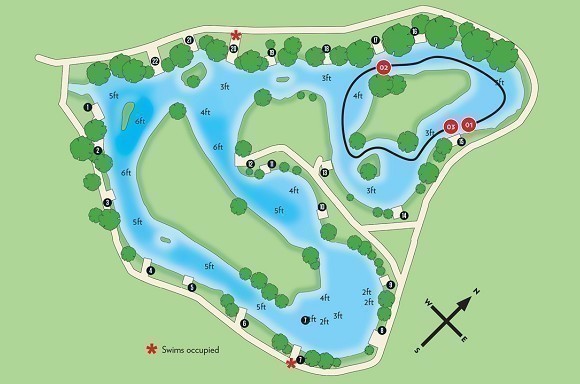
How carp react to environmental factors
Having watched, tracked and caught the odd carp, Ben Gratwicke shares his experiences on how carp react to environmental factors…
By this I mean weedbeds, snags, features or something a little different in the lake such as inflows, springs or coloured water. Carp will react to the topography of a lake too, for example in the height of summer the warmer shallow areas are favoured, whereas the depths of winter can find them held up in deeper, snaggy areas or areas of weed or an undulation in the lakebed. Remember: it’s not always the deepest part of the lake but often the most comfortable area.
Carp love a new smell so inlets of any size will often find carp mooching around, sniffing the new smells and tastes with any coloured water being investigated to the full. Fresh weed growth will harbour new food and carp will switch on to these newly-formed areas for a nice supply of snails or shrimps. Areas sheltered from the winter winds or shaded from the hot summer sun are all areas that may hold the odd fish or two. I have witnessed fish turning up at a certain snag, at a certain time of day to meet up, relax and rest for the day. Often fish from all round the lake would travel to said snag and I am sure they would be able to smell what the other carp had been eating and maybe follow them to have some of this nice smelling food. Like cormorants, you get one at your lake, then two the next day and so on and so forth because I am sure when they roost at night their fellow cormorants can smell the fish on them so next day they follow them.
Carp are creatures of habit and if you can put all the pieces together as a general rule then success will not be far away. Too many anglers I see get conditioned into the same track of thought and therefore have the same results as everyone else. If you want to catch more, you have to work that extra bit harder. Think harder and push that extra yard.
We chipped a carp!
CARPology, along with Ben Gratwicke (the author of this article) and Mr. William (Bill) Beaumont who works for Game & Wildlife Conservation Trust, chipped a carp (we named him Billy) at Diggerlakes so we could study its movements and understand what affects its behaviour. Here’s the result…
1: Sluices; 2: 2nd Sluice; 3: 3; 4: Sedges; 5: Sedges; 6: Brambles; 7: Small Steps; 8: Inlet; 9: Back Bay; 10: Middle Bay; 11: Middle Bay 2; 12: Cut off; 13: Cut Through; 14: Cut Through 2; 15: Tyre Bay; 16: Big Steps; 17: Tyre Island; 18: Narrows; 19: Narrows; 20: Big Junction; 21: Behind Island; 22: Small Junction
How environment factors can change how our chipped carp reacts
Weather conditions
Pressure: 1018mb
Temperature: 14 degrees
Wind direction and strength: Southwesterly, strong at times
General: Cloudy with rain at times heavy
Angling pressure
Swims occupied: 7 and 20
7am to 3pm: Billie was with a large group of fish to the right of Swim 15 (Movement 1) and there were a lot of fish showing and feeding in this area. The wind was strong and blowing into this area too. With no angling pressure, Billie spent most of the day here but did venture up in front of Swim 17 (Movement 2) for a while only to be back into Tyre Bay later on (Movement 3).
6pm: Ben Jenkins tracked Billie in the same corner and phoned me to say where she was but also that two of the big ‘uns were present and could be seen right in the edge with many of the smaller ones drifting around.
Comments: As mentioned, the fish love to get in this area when it’s quiet and when the wind is in the right direction. Ben’s two spots he had baited were getting worked daily and fish could be seen topping and feeding all over the bay. Ben also commented on the abundance of snails in the corner, along with new weed growth which was evident.



